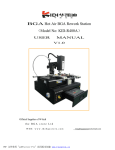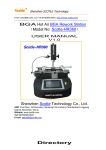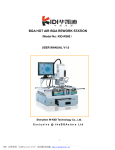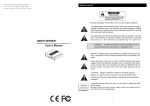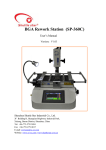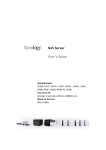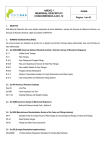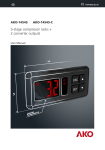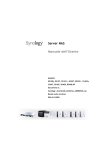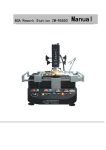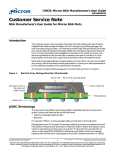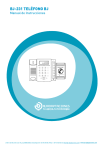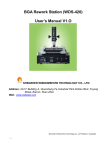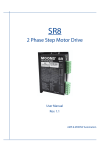Download KIDI R450A english manual
Transcript
BGA Hot Air BGA Rework Station (Model No:KIDI-R450A) USER MANUAL V1.0 Shenzhen W-KIDI Technology Co., Ltd. : : PDF 文件使用 "pdfFactory Pro" 试用版本创建 www.fineprint.cn Directory Ⅰ.Instructions on Installation and Operating precautions ...........................1 Ⅱ. Introduction of Rework Station KID-R450A..........................................3 Ⅲ. BGA Operating Procedures.......................................................5 ⒈Bakeout:.....................................................................5 2.Clamping board:..............................................................6 3. Remove/Desolder:............................................................8 4.Clean Land:..................................................................9 5. BGA Reball:.................................................................10 6. BGA reball soldering:......................................................13 7. Apply solder flux:.........................................................14 8. Mounting:..................................................................14 9. Solder:....................................................................14 Ⅳ.Introduction of Touch Screen Control ............................................15 V. Creating a Profile.............................................................20 Ⅵ. Installation of Supporting Clamp for Laptop PCB ................................24 Ⅶ. Alarm Malfunction and Solutions ................................................26 Ⅷ. Maintenance...................................................................27 Ⅸ. KIDI-R450A Technical Parameters ................................................28 PDF 文件使用 "pdfFactory Pro" 试用版本创建 www.fineprint.cn Ⅰ.Instructions on Installation and Operating precautions Assembling Site To ensure security and avoid possible damages, the Rework Station should be located where it complies with following conditions: ◆ Away from inflammables. ◆ Free from splashing of water or other liquids. ◆ Free from the direct airflow impact from air conditioner, heater or ventilator. ◆ With good ventilation, dry and free from excessive dust. ◆ Stable and flat location that is free from vibration and shock. Power Supply Power and voltage should meet the below requirements. ◆ Use the power supply with little voltage fluctuation Voltage fluctuation: AC220V±10%。 Frequency fluctuation: 50/60Hz±0.3%。 Space requirements: To facilitate operation and maintenance when we have to move the machine forward/backward and turn it, it is required to reserve a room that is >300mm far from the back. Operation Precautions: While operating the rework station, pls follow the following precautions: 1. After switching on the power supply, firstly check if there is airflow blowing from the 1 PDF 文件使用 "pdfFactory Pro" 试用版本创建 www.fineprint.cn upper/lower hot air nozzle. If not, it is prohibited to start heating. Otherwise the heater will get burnt. 2. Set different profiles for various BGA. The maximum temperature setting of any segment of the profile shall be less than 300℃. Refer to the BGA tin bead welding profile while using the lead-free rework. 3. Check the PCB land and BGA tin bead one by one before mounting BGA. After mounting, check the appearance one by one. If any abnormal symptom occurs, stop mounting and check the temperature immediately. The soldering can be continuously performed only after the proper adjusting. Otherwise it may damage the BGA or PCB plate. 4. Regularly clean the surface of the machine. In particular, keep the IR heating board surface clean. Prevent the dirt drops on it. The dirt may affect the proper heat radiation and result in poor welding quality as well as considerably reduce the lifetime of the IR heater. 5. Untrained operator can’t change any set parameters. 6. Avoid electric fans or other equipments blowing toward to the rework station while it is working, or it may cause the heater’s abnormal temperature rise, and the work piece will get burnt. 7. While it is working, don’t put any stuff on the heating area. Otherwise the stuff will get burnt. The PCB should be put on the supporting frame. 8. It is prohibited to touch the heating area to avoid burn while working. 9. While working, keep the rework station away from the flammable sprays, liquid or gas. 10. Don’t remove the front panel or cover of the electric cabinet that is with HV (high voltage) components in that may cause electric shock. 11. In case the metal or liquid falls into the station while it’s working. Shut off power and pull out the plug. Clean away all the dirt after the machine cools down. It will give out bad smell if there is dirt when it restarts. Note: Never clean the IR heater (heating board) with liquid. Use fine sand paper to rub away the stubborn dirt on the IR heating board. We will be irresponsible for replacing the heater for free for the previous mentioned reason. 2 PDF 文件使用 "pdfFactory Pro" 试用版本创建 www.fineprint.cn Ⅱ. Introduction of Rework Station KID-R450A BGA Rework Station KID-R450A made by W-KIDI has 3 heaters (Upper Heater, Lower Heater and Bottom IR Heater). The upper and lower heaters heat directly towards BGA part to ensure BGA gets enough heat to reach the melting point to come to good welding quality. The bottom heating zone is large area IR heating board for preheating the whole PCB board to insure even heating and prevent the PCB get deformed. KID-R450A Diagram: 3 PDF 文件使用 "pdfFactory Pro" 试用版本创建 www.fineprint.cn Parts name: 1、Knob for fine-adjusting the height of the upper heater 2、Knob for locking the upper heater from moving forward/backward 3、Handle for locking upper heater from rotating 4、Knob for adjusting upper heater up/down 5、Upper heater 6、Upper nozzle 7、Lower nozzle 8、Lower heater 9、Knob for adjusting the lower heater up/down 10、Vacuum pen 11、USB port 12、Temperature sensor joint 13、Touch screen 14、Knob for locking PCB jig 15、Knob for positioning PCB 16、LED lamp 17、PCB supporting bar 18、PCB clamping device 19、Bottom IR heating board 20、Cooling fan 21、Power switch 22、Lamp on/off 23、Laser light on/off 4 PDF 文件使用 "pdfFactory Pro" 试用版本创建 www.fineprint.cn Ⅲ. BGA Operating Procedures BGA rework on PCB should comply with the following procedures: ⒈Bakeout: Both PCB and BGA must be baked in a constant temperature oven at a temperature range from 80℃~100℃ for 8h~20h. The purpose of baking is to dehumidify the PCB and BGA in case blowout during rework. Table 1 Moisture sensibility grade: Context Saving Grade Time 1 Timeless ≤30℃/85% RH 2 1 year ≤30℃/60% RH 2a 4 weeks ≤30℃/60% RH 3 168hs ≤30℃/60% RH 4 72hs ≤30℃/60% RH 5 48hs ≤30℃/60% RH 5a 24hs ≤30℃/60% RH 6 Refer to the labeled time (RH: relative humidity) ≤30℃/60% RH Table 2 Baking time: Seal Humidity thickness sensitivity grade ≤1.4MM 2a 4hs 3 7hs 4 9hs 5 10hs 5a 14hs 2a 18hs 3 24hs 3 31hs 5a 37hs 2a 48hs 3 48hs 3 48hs 3 48hs 5a 48hs ≤2.0MM ≤4.0MM Baking time 5 PDF 文件使用 "pdfFactory Pro" 试用版本创建 www.fineprint.cn 2.Clamping board: 1.1. To select proper upper nozzle and lower nozzle suitable for BGA sizes. 1.2. Upper nozzle is fixed on the upper heater head. Tighten the screw to fix the nozzle that can be adjusted as per BGA position and angle. Lower nozzle is fixed on the lower heater. Rotate the up/down fine-adjusting knob to lift the nozzle and then tighten the screw to fix the nozzle. Diagram: Screw for fixing upper nozzle Upper nozzle Lower nozzle Knob for up/down adjusting lower nozzle Screw for fixing lower nozzle 2. 3.Adjust upper and lower nozzle positions; rotate the knob to lower the upper heater; by moving upper heater backward/forward, make the centre of upper nozzle and lower nozzle align. After adjusting, lock the forward/backward handle and fix the heater not moving forward/backward. Then lift the upper heater. If need to rotate upper heater, loosen the upper heater rotate lock. If not, tighten it. 3. 6 PDF 文件使用 "pdfFactory Pro" 试用版本创建 www.fineprint.cn Knob for locking the upper heater from moving forward/backward Diagram: Adjust the position of nozzles Knob adjusting upper heater up/down Knob for locking upper heater from rotating 2.4.Adjust PCB clamping device and PCB support bar, close up the clamping device and support bar both sizes before putting PCB on it, then lift the PCB support pillar( which can be adjusted to a proper position according to PCB size) and make it be in line with the stage of the PCB clamping device( which prevents the PCB from getting deformed). As shown in the following picture: PCB support pillar PCB clamping device Hole for putting support pillar 2.5. Put PCB onto the support bar, then align BGA chip with the upper and lower nozzles, make their cores in one line. Adjust PCB clamping device till the board is in the stage of the clamp device. As shown in the following diagram: 2.6 Lower the upper heater head, adjust PCB forward & backward, make sure the upper nozzle can cover the whole BGA chip, then lock the positioning mechanism for clamping. Meanwhile adjust PCB clamping device left & right, make sure the whole 7 PDF 文件使用 "pdfFactory Pro" 试用版本创建 www.fineprint.cn BGA chip is covered by upper nozzle completely, finally lock the positioning mechanism for clamping. As shown in the following diagram: PCB put on the stage of clamping PCB positioning mechanism for clamping Knob for lock Clamping device Conclusion:A qualified board clamping should be as follows: The whole PCB must be inside of the bottom area IR heater, so that is can be heated evenly. The upper nozzle must properly cover the BGA, so that the chip can be heated evenly. Besides, the cores of BGA chip, upper and lower nozzle must be in one line. Observe bottom of PCB to make sure the supporting pillar and bottom nozzle can support the surface of the PCB. The upper nozzle heating position (lowest position) is 1mm away from the BGA surface. 3. Remove/Desolder: 3.1 Clip PCB to the board supports, clamp and fix the PCB as what we introduced as above. 3.2 Select or set a suitable profile, click “Desolder” on the touch screen, the system will perform desolder process. When heating completes, it will alarm. Meanwhile the vacuum is ready ( it will buzz when the pen starts vacuum). Rotate the knob to lift the upper heater head, then immediately plug the hole of the vacuum pen with the thumb and take the red tip of the pen close to the surface of BGA to pick it up from the PCB. Release the vacuum pen, the BGA will come down from the pen. Then the cooling fan starts work. Cooling finishes. Take the PCB out from the supports. 8 PDF 文件使用 "pdfFactory Pro" 试用版本创建 www.fineprint.cn Distance 1-2mm between nozzle and BGA Cover the hole with thumb Vacuum pen’s hole Pick up the BGA after desoldering 4.Clean Land: The PCB land and BGA land must be cleaned in a short time after desoldering. Because the damage to the land is small while the PCB or BGA haven’t cooled down completely. Please refer to the following steps. (Cleaning PCB is the same) As shown as following diagram. 4.1 Prepare a soldering iron with temperature 370℃ ( for lead-free chip) and 320℃ (for leaded chip) 4.2 Apply a little layer solder flux to BGA equally 4.3 Mop the chip with the soldering iron to clean it. 4.4 Take a wick to clean the land until it is neat. 4.5 Wipe pad: To ensure the reliability of BGA soldering, wipe the pad with some volatile solvent, such as industrial alcohol. 9 PDF 文件使用 "pdfFactory Pro" 试用版本创建 www.fineprint.cn Apply solder flux with brush Mop the pad with soldering iron Mop with both iron and wick Wipe pad 5. BGA Reball: 5.1 Choose a stencil, a reballing kit and proper solder ball that match the BGA, put the stencil between the kit’s frame and cover, then screw up to lock the stencil. ( But please do not lock it tight, so that it can be fine-adjusted and moved) Stencil Screw Spare ball accumulator Kit’s frame 10 PDF 文件使用 "pdfFactory Pro" 试用版本创建 www.fineprint.cn 5.2 Apply solder flux to BGA equally, then place BGA as the picture showing below; adjust the locating block to make BGA’s diagonal and the reball kit’s diagonal match together, only in this case the BGA is located in the center of the reball kit; finally lock the four locating block it fix it. Locating block Apply solder flux Screw adjusting the gap between BGA and stencil Lower die Reball kit’s diagonal 5.3 Put the cover with stencil inside over the kit; then move the stencil lightly to make its holes match the BGA pins. In case this method is not good enough to make stencil’s holes and BGA pins match each other, (pay attention to the deviation place) remove the cover(frame), release the screw, readjust BGA and repeat all those actions only to make sure the stencil’s holes match the BGA pins; finally lock; otherwise, you have to fineadjust the stencil. 11 PDF 文件使用 "pdfFactory Pro" 试用版本创建 www.fineprint.cn Final lock Adjust stencil to make its holes match the BGA pins 5.4 Adjust the gap between BGA and stencil. By adjusting the Screw to make the gap between BGA and the stencil 2/3~3/4 of the ball diameter. Make sure one hole for one ball going through only and it is convenient to take out the stencil. 5.5 First, exam if the solder ball size matches the chip and stencil; second put it on the stencil as the following picture shows, then shake the whole kit lightly to let the ball drop to the BGA land through the stencil’s holes. Finally check whether every pin has been reballed ( make sure no pin missing), then we can put the spare balls aside and take out the cover.(note that tilt the kit while taking out the cover in case that the reballed balls go out from the holes of the stencil. After that, the qualifiedly-reballed BGA can be taken out. ( At this time if some pins found missing( not yet reballed, we can make it up by a right tweezers. ) After reballing completely, recollect the spare balls. 5.6 When change for other BGA chip of different size as well as solder ball, please repeat steps 1-4 12 PDF 文件使用 "pdfFactory Pro" 试用版本创建 www.fineprint.cn Put solder ball on stencil Tilt the kit Put the spare balls aside 6. BGA reball soldering: 6.1 Put the BGA with the balls on the heating area, and then solder the balls on the BGA land. Setting the soldering temp.(230℃ for leaded, 250℃ for lead-free). 6.2 After setting temperature, start the soldering station and wait for the temperature going up to the required value and keep constant temp.. 6.3 When constant temp., put the reballed BGA onto the soldering station with a hightemperature paper underlaid to heat, meanwhile use a hot air gun as a assistant heating from the upper surface. 6.4 When the balls are melted, they become shining liquid and line up. Then move the BGA to cooling station to cool down. Soldering finishes. Soldering heating station High temp. paper BGA balls are melted 13 PDF 文件使用 "pdfFactory Pro" 试用版本创建 www.fineprint.cn 7. Apply solder flux: 7.1 To guarantee soldering quality, make sure that the PCB land is free of dust before applying solder flux. The best way is to wipe the land before applying solder flux every time. 7.2 Apply a layer of soldering flux on the PCB solder land with a brush pen. Excessive flux may result in the balls shorted, in reverse, it easily causes missing solder. So the soldering flux coating shall be even with a proper amount so as to remove the dust and foreign materials from the BGA balls and improve the welding effect. (Applying solder flux to BGA is the same) 8. Mounting: Fix the PCB on the station. Mount the reballed BGA on the PCB in right position. When positioning, align BGA land with PCB land by referring to the silk-screen frame. Note that the direction sign on BGA should be corresponding with the one on PCB. 9. Solder: 9.1 Clip the PCB with renewed BGA placed to the supports, exam the alignment of BGA and PCB, adjust the supports. 9.2 Set or choose an appropriate profile according to the PCB type, press “Solder” button on touch screen, it will perform soldering process. When finish, it buzzes to alarm, meanwhile cooling starts as well.(The cooling time can be set in the profile) Then lift upper heater and put it aside. When cooling completes, take PCB out of the machine. Notes:The difference between Solder and Desolder process is the way of cooling, i.e. cooling starts right after soldering completes, but cooling starts 8 seconds (time is settable) after desoldering/removing process completes. 14 PDF 文件使用 "pdfFactory Pro" 试用版本创建 www.fineprint.cn Ⅳ.Introduction of Touch Screen Control 1:Main Menu Picture-1 l Peak Temp.: display the highest temperature the 1st thermocouple detected during heating process; clear away the latest record value when restart heating; l Vacuum: vacuum start switch; click it---vacuum on (button color becomes brown); Reset it— vacuum off (button color becomes white) l Cool: start or stop cooling fan by hand (Remarks: forbid starting it during the heating, and stopping it during the cooling time) l Hold: hold the current segment temperature during the heating process; l Solder: click it and soldering action starts with the temperature profile currently selected. l Desolder: click it and desoldering action starts with the temperature profile currently selected. l Segldx: the current segment No. the upper temperature profile runs to; l Upper: the actual temperature of upper heater l Lower: the actual temperature of lower heater l Bottom: the actual temperature of bottom IR panels l 1st TC: display the actual temperature of thermocouple-1 on the port. l 2nd TC: display the actual temperature of thermocouple-2 (can expand to two way thermocouple ports) l Remaining time: the remaining time for the upper heater in the current stage; 15 PDF 文件使用 "pdfFactory Pro" 试用版本创建 www.fineprint.cn l Heating time: the total heating time; l Remaining cool time: cooling time countdown when the cooling fan starts; the cooling fan stops when counting down to ”0”; l Reflow time: to analyze the time when the 1st thermocouple temperature exceeds solder ball melting point; during the reflow, the temperature rises from ball melting point to the peak temp. and then drop from the peak temp. to the melting point; l Main menu: as show as picture-1 l Advanced menu: to manage, set and display the temperature profile parameters; l Assist menu: to include auto profile, PCB bake and BGA reballing operations; 2:Advanced menu Picture-2 l Profile No.: the current profile number; Number range:1~49 l Save: to save the current values to the database of background system permanently; l Segment No.: S1~S8, the temperature profile segment number; l Upper(℃):the set temperature in each segment for the upper part; l Time(S):the constant temperature time in each segment; l Lower(℃):the set temperature in each segment for the lower part; l Time(S): the constant temperature time in each segment; l Bottom Temp.:the set temperature for the bottom IR panels; l Reflow Temp.: to analyze the 1st thermocouple over the melting point temperature time 16 PDF 文件使用 "pdfFactory Pro" 试用版本创建 www.fineprint.cn of soldering ball l Alarm Temp.:the high temperature alarm when system reaches this alarm temperature value; l Cool time: the running time of the cooling fan after heating finishes. l Upper air speed:control the air speed for the upper heater ( input range:1-3; 1, 2, 3 is corresponding to low speed, intermediate speed, high speed) l Lower air speed:control the air speed for the lower heater (input range:1-3; 1, 2, 3 is corresponding to low speed, intermediate speed, high speed) l Nozzle Size: the corresponding nozzle size for the current profile used. 3:Assist Menu Picture-3 Auto-generate Profile: l Standard mode:suitable for most of common PCB boards and BGA without special requirements; in this mode, lower temperature is a little higher than upper temperature. l High Temp.-Top:Mainly for BGA with heat sink itself and good heat-resistance or some BGAs under which there are some heat reactive components. In this mode, upper temperature is higher than lower temperature. Desoldering and soldering mainly depends on the upper heating, and lower heating is as an adjunctive one. l High Temp.-Bottom:mainly for Crystal-bare BGA and double-layer BGA. In this mode, lower temperature is higher than upper temperature. Desoldering and soldering 17 PDF 文件使用 "pdfFactory Pro" 试用版本创建 www.fineprint.cn mainly depends on lower heating, and upper heating is as adjunctive one。 l Special mode:Mainly designed for desoldering of glued boards and some boards with requirements for low peak temperature. l leaded / leadfree : to integrate the process change for leaded and leadfree profiles internally; l Auto calculate:to click it to perform desoldering; while heating, system auto-calculates and changes target profiles. PCB Bake l Setting Temp.:the set temperature for bottom IR l Actual Temp.:the actual temperature of bottom IR in current l Output limit : the Max output power of bottom IR, input range: 0~32000, 32000 corresponds to 100% power; l Setting time: to set the bake time; system will stop heating automatically when time is up; l Remaining time::the time countdown of the whole baking process l Run:start button for baking BGA Reballing l Setting Temp.:the set temperature for lower heater l Actual Temp.:the actual temperature of lower heater l Air speed::input range 1~4 l Setting time: the required heating time for the reballing l Remaining time: the countdown of reballing l Run:start button for reballing ★ Maintenance skill 1. When we are not sure if the BGA is lead-free or leaded, for safety, we had better treat the BGA as leaded. Enter the leaded temp. profile, insert the wire sensor into BGA, start desoldering on the touch screen. Check if the BGA melted with nipper when the measured temp. up to 190℃. It is leaded BGA if the ball melt. It is lead-free BGA if the ball melt when 217℃. 2. Select proper profile based on BGA size and PCB thickness, We need to increase the 18 PDF 文件使用 "pdfFactory Pro" 试用版本创建 www.fineprint.cn bottom temp. if the PCB is too thick. 3. For usual computer board, the temp. setting are similar. The temp. for north bridge is several degrees higher than south bridge. In case the notebook PCB, the lower temp. setting is high with the upper temp. at 210-220℃ for the display card. If the upper temp. setting is high, the balls on video memory will melt that will result in failed soldering. 19 PDF 文件使用 "pdfFactory Pro" 试用版本创建 www.fineprint.cn V. Creating a Profile To set BGA temp. profile, insert the wire sensor into BGA to check if the profiles meet the requirements. Our company provide with lead-free and leaded profile for reference. Entry parameter setting screen, set the profile parameters as per various BGA types as following. Leadfree profile setting (Fig. 1) During the whole heating process, there are 8 stages from preheating to cooling, but usually only 5 stages are enough and available 1. PRE. , Stage 1: preheating the board; in this stage, temperature is low, usually below 100℃; 2. RISE, Stage 2, temperature rising; in this stage, we want temperature rise quickly, so we usually set 205℃ for lead-free and 190℃ for leaded. 3. Cons. , Stage 3, keeping temperature constant, in this stage, we keep a constant temperature of 20-30℃ lower than stage 2 so as to wipe off the impurity on the board, because during this period the flux is volatilizing which does good for wiping off the impurity. 4. REF. , Stage 4, ball melting and reflowing; in this stage, the ball begins to melt and reaches to the peak, so the temperature should be high( usually is highest) and time should be long. 5. REF. , Stage 5, reflowing( from the peak to ball’s melting point); in this stage, temperature must be lower than Stage 4, and time usually is 5~10S in upper heater. 20 PDF 文件使用 "pdfFactory Pro" 试用版本创建 www.fineprint.cn Insert the wire sensor into the BGA to test the temp. of balls Testing temperature (Fig. 2) 6. Check the PCB to be repaired, and confirm it is leaded or leadfree. E.g. PCB is leadfree (of course BGA also leadfree): First of all, we choose a leadfree profile and check the settings (as in shown Fig. 1). Second, clamp the PCB to the supports and insert wire sensor into BGA (for testing temperature). Third, start “desoldering” (as in shown Fig. 2). When heating completes, look over the ‘Analyze’ column to check the preheat time, reflow time and max. temperature (peak) whether they meet the requirement of leadfree technology. (as in shown Fig. 1) 7. If every parameter in Fig. 1 meets requirement, that means this profile is suitable for this BGA, then we can save it as “LF+ (BGA model number). Next time we repair the same BGA chip as this, no need to test the profile any more, but use it directly. In reverse, we havetochangesettingsthensave. 8. If the max temperature/peak (TC) is lower or higher than the standard required temperature 245 ( leadfree), we can take ℃ a method as follows: e. g. The tested Max temperature is 220℃, (245-220)×1. 2=30 e. g. The tested Max temperature is 260℃, (245-260)×1. 2= -18 We put “30” or “-18” to “offset”, then we can get a suitable profile. 9. If the preheat time is too short which doesn’t meet requirement (60~90s leadfree), there are two solutions to make a suitable profile: 9. 1. When the profile running finishes stage 2 with a temperature (TC) below 150℃, we can increase the set temperature or prolong the time in this stage on both upper and 21 PDF 文件使用 "pdfFactory Pro" 试用版本创建 www.fineprint.cn lower parts. The standard requirement is that TC/ wire sensed temperature must up to 150℃ when stage 2 ends. 9. 2 The profile running finishes stage 2 with a temperature (TC) of 150℃ or more. In this case, we should prolong the time in stage 3. The prolonged time must be the number missing in preheat time. i. e. We prolong how much seconds it misses in the preheat time ( preheat time must be between 60~90s). 10. If reflow time is too short below (40~90s) which also does not meet requirement, 10. 1 The solution is to prolong time in stage 4 or 5. The same as point 9. 2. i. e. to prolong how much seconds it misses in the reflow time( reflow time must be between 40~90s) 10. 2 Suppose the preheat time and reflow time are too long (preheat time over 60~90s, reflow time over 40~90s), we can take a reverse method of the above. 10. 3 After changing the setting, we get a new profile. Also we have to test this new profile again. The method of testing is the same as what we mentioned in Fig. 2. Even this profile is still not qualified, we have to change and readjust setting again and again until it is qualified, then save in the machine. Leaded profile setting The method worked on leaded BGA chip is the same as lead-free one. ★ Rework Skills 1、If we are not sure the BGA is leaded or leadfree, for safety concerns, we take a leaded profile to test (To test means to desolder a BGA with the wire sensing inserted). During heating, when “TC” on the touch screen goes to 190℃, flip the BGA with a tweezers. 22 PDF 文件使用 "pdfFactory Pro" 试用版本创建 www.fineprint.cn Here, if the balls are already melted, we can say it is leaded. In reverse, we can say it is leadfree. Only when “TC” goes to 217℃ can the BGA balls be melted, we might know it is leadfree. 2、Usually we select or make an appropriate profile according to the size of BGA and the thickness of PCB. The thicker PCB is, the more temperature in lower part we need to increase. 3、Profile setting for South Bridge and North Bridge is almost the same. But exactly NB(North Bridge) needs a little more temperature than SB(South Bridge). (usually a few degrees only) For the two-store VGA on laptop motherboard, we need to increase temperature in lower part and decrease temperature in upper part a bit( in stage 4 of upper part, set 210-220℃). The reason why we do so is that high temperature in upper part will damage the small chips on the VGA. 23 PDF 文件使用 "pdfFactory Pro" 试用版本创建 www.fineprint.cn Ⅵ. Installation of Supporting Clamp for Laptop PCB Usage of clamps for laptop PCB: 1. We offer a set of clamps for laptop PCB along with the machine (6pcs) as shown in the following picture. Jigs Clamps 2. The clamps are fixed on the tapped hole of PCB supports according to the PCB size, fixed by rotating the knob, as shown in the following picture: Tapped hole Knob ` 24 PDF 文件使用 "pdfFactory Pro" 试用版本创建 www.fineprint.cn Fixing 3.Clamping laptop PCB, put PCB on the supports, make sure the cores of BGA, upper nozzle and lower nozzle are in a line. Adjust PCB clamping device, move the clamps to the holes on PCB and fit, then fit the knob on the supports, finally pull the clamps tight before tighten the knob to make the PCB neat. Refer to the following picture: Knob fix Locking the PCB 25 PDF 文件使用 "pdfFactory Pro" 试用版本创建 www.fineprint.cn Ⅶ. Alarm Malfunction and Solutions 1. Upper part heating abnormal! 1.1. Reason: a. After starts heating, with the power consumption of more than 99%, if the practicallysensed temperature is below 150℃, the upper heater should heat up at a speed of more than twice of the it’s normal. b. If the practically-sensed temperature is over 150℃, the upper heater should heat up at the speed of 0.1℃/S. c. If any of the above two situations can not be qualified, the system will give alarm. 1.2. Troubleshooting: a. make sure the temperature parameter setting is correct b. check whether the blast blower, upper heating coil and upper temperature-sensing wire is working. 2. Lower part heating abnormal! 2.1. Reason:After starts heating, with the power consumption of more than 99%, if the practically-sensed temperature is below 150℃, the lower heater should heat up at a speed of more than twice of the it’s normal speed. If it can not reach that temperature standard continuously for 5s, the system will give alarm. 2.2. Troubleshooting: a. make sure the temperature parameter setting is correct b.check whether the blast blower, lower heating coil and lower temperature-sensing wire is working. 26 PDF 文件使用 "pdfFactory Pro" 试用版本创建 www.fineprint.cn Ⅷ. Maintenance In order to guarantee the machine function and prolong service life of the machine, during usage, we have to do some maintenance on the system regularly as follows: Maintenance Components name Maintenance method period Open the cover, clean the fan with Upper heater Up& Down Drive mechanism on upper heater 1 month high-pressure air Apply some butter on lead rail, rack, gear and other drive 1 month mechanism Open the front cover of the machine, use vacuum cleaner to Electronic box suck the dust and dirt, and check 3 months whether the components fixed well Forward& Backward Driver on upper heater Rotating part of upper heater Apply some butter on lead rail, rack, gear and other drive 1 month mechanism Apply some butter on lead rail, rack, gear and other drive mechanism 1 month Clean the heating tube with dry Bottom IR heating panel cloth(do not use wet one) 1 day Apply some lubricant to the PCB PCB clamps supports and shaft of support 1 month guiding axle 27 PDF 文件使用 "pdfFactory Pro" 试用版本创建 www.fineprint.cn Ⅸ. KIDI-R450A Technical Parameters Technical Parameters Applicable PCB Applicable BGA Temp. Control PCB size 460mmX370mm Workable area 460X370mm Max. PCB thickness 3mm Max. size 60mmX60mm Min. size 2mmX2mm Max. weight 80g Top heater 350℃ Lower heater 350℃ Sub(bottom) heater 300℃ 16sections Temperature control of programmable temperature control setting Power for operation 3800W Main heater 600W Lower heater 800W bottom heater 2400W Dimension(LxWxH) 620*600*650mm Weight 30KG Power consumption System Parameters Input voltage Power for requirement 28 PDF 文件使用 "pdfFactory Pro" 试用版本创建 www.fineprint.cn AC 220V 4KW Shenzhen W-KIDI Technology CO., LTD. 深圳市华凯迪科技有限公司 Please kindly understand we will not keep you informed if there are some revised parameters due to we have been developing and improving the technology always. SHENZHEN W-KIDI CO.,LTD E-mail:[email protected] 29 PDF 文件使用 "pdfFactory Pro" 试用版本创建 www.fineprint.cn































